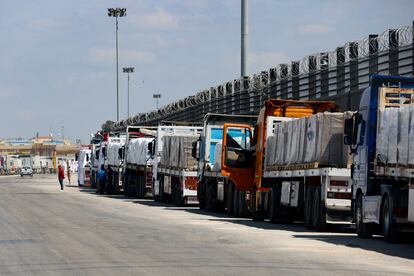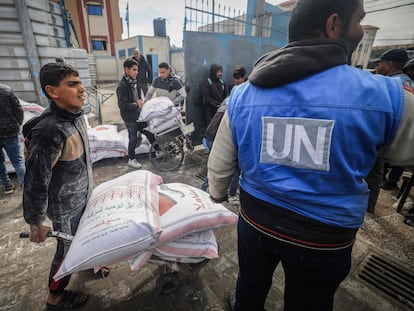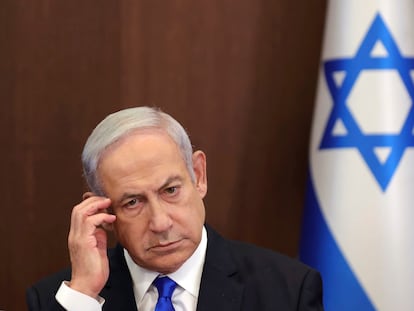Despite Israel’s commitment to Biden, the Erez crossing into Gaza remains closed to aid
The Israeli government has also not yet allowed the landing of humanitarian supplies for the Strip in the nearby port of Ashdod


The Erez border crossing, which connects Israel with northern Gaza, remains closed and no humanitarian aid has been allowed to enter the Strip through it, according to Juliette Touma, director of communications for the United Nations agency for Palestinian refugees (UNRWA), speaking to EL PAÍS from Jordan. Touma stresses that the announcement last Thursday by the Israeli authorities that they would reopen the crossing remains only “a promise.” The Israeli government implicitly confirmed the information to this newspaper. Supplies to alleviate the plight of Gaza’s population have also not yet begun arrive via the nearby port of Ashdod, 30 kilometers (18 miles) north of the enclave. These two concessions were the main commitments made by the Israeli War Cabinet following a telephone call between Prime Minister Benjamin Netanyahu and U.S. President Joe Biden.
“We will announce [the reopening] of [the Erez crossing] and [the port of] Ashdod when a date is set,” Shimon Freedman, spokesman for the Coordination of Government Activities in the Territories (COGAT), which is in charge of authorizing the entry of humanitarian aid into Gaza, said in a message to this newspaper on Monday. Freedman did not respond to questions about an approximate date for the reopening of the crossing, which, prior to the October 7 Hamas attacks in which 1,200 people were killed and 240 taken hostage, served primarily for the movement of people.
COGAT did announce Sunday evening that the number of aid trucks that had entered the Strip that day was 322, the highest figure since the beginning of the war but still far short of the 500 to 600 a day needed to feed the Gazan population, according to the United Nations. “It is a drop of water in an ocean of need,” Ghada Al Haddad, spokeswoman for the NGO Oxfam in the enclave, said in a telephone conversation from Deir al-Balah, in central Gaza.
Israel only allows aid trucks to enter Gaza through two other crossing points: Rafah and, to a lesser extent, Kerem Shalom, both in the south. It has done so in dribs and drabs since the Israeli government decreed a total blockade of the Strip days after the Hamas attack, to which Israel responded with a military offensive that has already killed more than 33,000 Palestinians, according to the Ministry of Health in the Strip, which is governed by Hamas.
In the statement announcing the reopening of Erez and Ashdod, Israel did not offer dates, but did indicate that it would take “immediate steps” to increase the flow of humanitarian aid to Gaza. Washington, its primary supporter, welcomed the announcement, albeit more circumspectly than on previous occasions. Adrienne Watson, spokesperson for the National Security Council, even warned that these steps should be “fully and rapidly implemented.”
Hours earlier, Biden and Netanyahu had held a telephone conversation described as “tense” by the U.S. media. The previous Monday, an Israeli strike killed seven aid workers in Gaza, including one American, from the NGO World Central Kitchen (WCK). Biden warned Netanyahu during that call that there would be changes in Washington’s support if Israel did not take immediate steps to protect civilians and increase humanitarian aid in the Palestinian territory. More than half of Gaza’s 2.2 million people face an extreme lack of access to food, according to an international report released in March, which warned of “imminent” famine in northern Gaza.
Israel has not yet opened Erez and Ashdod to aid, but it did on Sunday show U.S. Ambassador Jack Lew its military Humanitarian Coordination and Deconfliction Cell, a new institution also announced last Thursday, whose task will be to prevent “mistakes” — as Israel defined the attack on the WCK convoy. COGAT published images of Lew’s visit on social media, as well as highlighting the entry of the 322 aid trucks into Gaza.
This newspaper asked the COGAT spokesman how this sudden increase in the number of vehicles was possible when Israel has in the past attributed the low number of trucks entering Gaza to the “lack of logistical capabilities” of United Nations agencies, especially UNRWA. His response was: “In terms of the number of trucks, the main problem facing the international community is their distribution capacity.” Freedman attributed the increase in the number of vehicles to “Israel’s efforts to increase its capacity and the large number of trucks that have been sent by the international community.”
The spokesman also maintained that Israel has “significantly increased its inspection capacity.” The UN and several international NGOs have accused the country of blocking, sometimes for weeks, trucks from entering Gaza on grounds such as finding children’s scissors in the cargo. The UN maintains that Israel is using hunger as a “weapon of war.”
The “illusion of aid”
Fidaa al Araj, Oxfam’s Food Security, Cash and Protection coordinator in Rafah, confirms by telephone that more aid has been entering Gaza in recent days, but that it is still “extremely insufficient.” The more than 500 trucks that were entering the Strip before the war were already “insufficient after 16 years of Israeli blockade,” she adds. During the current conflict, she explains, there have been days when only 40 trucks have entered. “An increase now is an Israeli strategy for the media,” she says.
These vehicles entering Gaza are not always carrying food, says Doaa, a Gazan refugee in Rafah. “Every truck that comes in is counted as aid, even though some are carrying Covid-19 tests. Others bring food, but not all of it is not for distribution, instead it goes to traders who sell it at very high prices. A kilo of sugar used to cost 75 cents and now it costs €16.5. People cannot afford it because of the financial collapse and lack of cash caused by the war. There are no fruits and vegetables in the markets, and if there are, the prices are astronomical due to Israel’s complex procedures to get them into Gaza.”
This is the context to which the secretary general of Doctors Without Borders, Chris Lockyear, referred last week, alluding to what he called “the illusion of aid.” “The image of humanitarian aid is being used as an alibi to perpetuate the brutal and disproportionate way in which this war is being waged,” he said in a statement.
“Much of the narrative around humanitarian assistance has been around counting trucks crossing a border and airdrops. These are simply distractions meant to create an illusion of aid […] Humanitarian assistance is much more than just counting trucks. It is moving supplies around safely. It is security at the point of distribution. It is functioning hospitals which are more than four walls and a roof. They are water, electricity, fuel, and communications,” he stressed.
Sign up for our weekly newsletter to get more English-language news coverage from EL PAÍS USA Edition
Tu suscripción se está usando en otro dispositivo
¿Quieres añadir otro usuario a tu suscripción?
Si continúas leyendo en este dispositivo, no se podrá leer en el otro.
FlechaTu suscripción se está usando en otro dispositivo y solo puedes acceder a EL PAÍS desde un dispositivo a la vez.
Si quieres compartir tu cuenta, cambia tu suscripción a la modalidad Premium, así podrás añadir otro usuario. Cada uno accederá con su propia cuenta de email, lo que os permitirá personalizar vuestra experiencia en EL PAÍS.
¿Tienes una suscripción de empresa? Accede aquí para contratar más cuentas.
En el caso de no saber quién está usando tu cuenta, te recomendamos cambiar tu contraseña aquí.
Si decides continuar compartiendo tu cuenta, este mensaje se mostrará en tu dispositivo y en el de la otra persona que está usando tu cuenta de forma indefinida, afectando a tu experiencia de lectura. Puedes consultar aquí los términos y condiciones de la suscripción digital.
More information
Archived In
Últimas noticias
There is as much life left to discover on planet Earth as that which is already known
Dozens presumed dead, around 100 injured in fire at Swiss Alps bar during New Year’s celebration
Is porn for women different from conventional porn? We spoke to those who make it
Cartagena de Indias is sinking: What can the city do to mitigate it?
Most viewed
- Reinhard Genzel, Nobel laureate in physics: ‘One-minute videos will never give you the truth’
- David King, chemist: ‘There are scientists studying how to cool the planet; nobody should stop these experiments from happening’
- Oona Chaplin: ‘I told James Cameron that I was living in a treehouse and starting a permaculture project with a friend’
- Sinaloa Cartel war is taking its toll on Los Chapitos
- The Interoceanic Train, the Mexican alternative to the Panama Canal










































